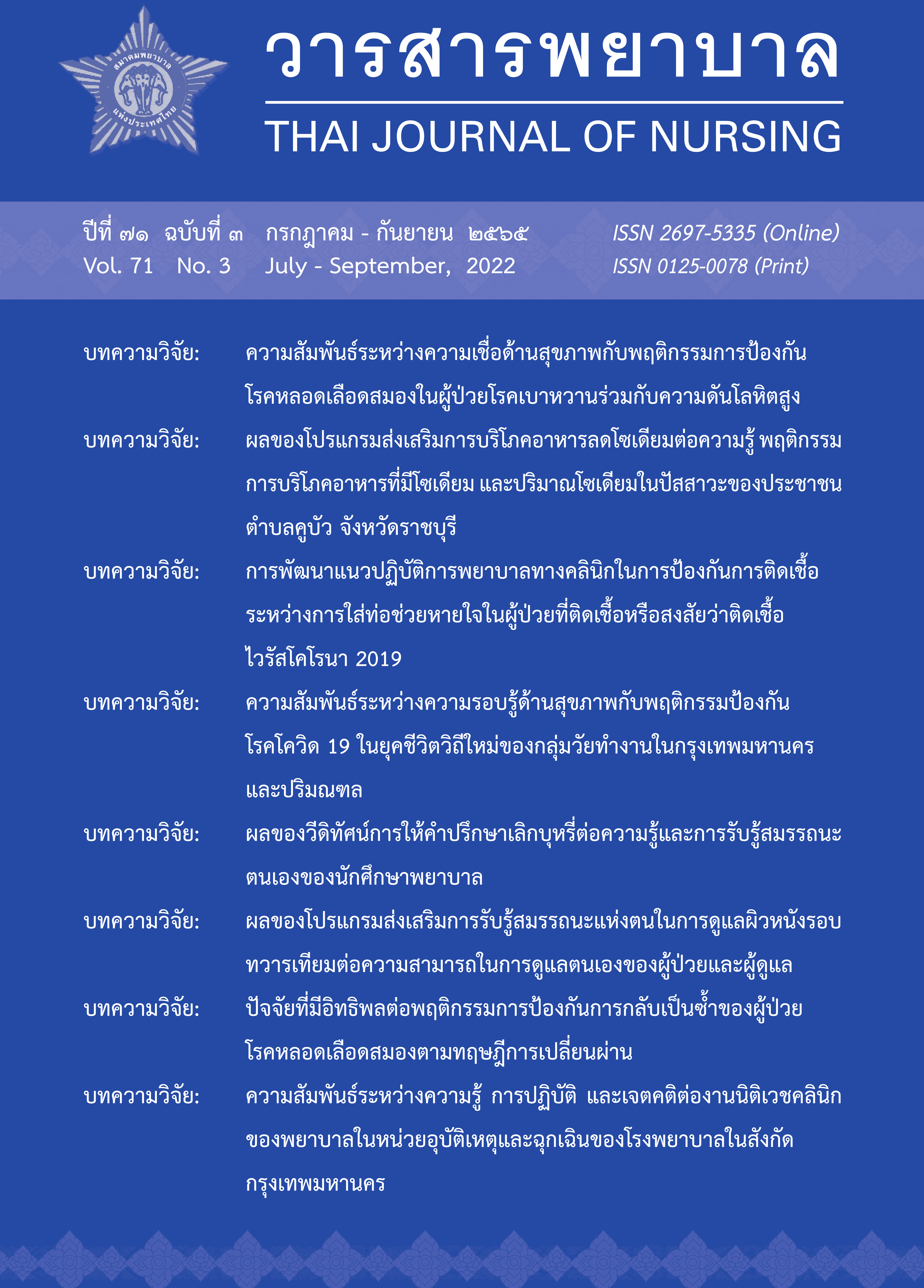Factors influencing recurrent preventative behavior of stroke patients based on transition theory
Main Article Content
Abstract
This predictive correlational research aimed to examine factors influencing recurrent preventative behavior of stroke patients. The Meleis’s Transition Theory was modified to establish the conceptual framework. The subjects consisted of 105 stroke patients after discharge from hospital and were purposively sampled according to the inclusion criterias. Data were collected using questionnaires on demographic data, stroke awareness, community support and stroke recurrent preventaive behavior. The Cronbach’s alpha coefficients were 0.76, 0.89, and 0.75 respectively. The data were analyzed using descriptive statistics and stepwise multiple regression analysis. The results showed that factors influencing recurrent preventative behavior of stroke patients were awareness of stroke (β = 0.466) and community support (β = 0.289). These factors combined could explain 37.9 percent of the variance in stroke recurrent preventative behavior at statistically significant level of .05.
Article Details

This work is licensed under a Creative Commons Attribution-NonCommercial-NoDerivatives 4.0 International License.
References
กระทรวงสาธารณสุข กรมควบคุมโรค กองโรคไม่ติดต่อ. (2562). จำนวนและอัตราตายด้วยโรคไม่
ติดต่อและการบาดเจ็บประจำปีปฏิทิน พ.ศ. 2562. สืบค้นเมื่อ 20 กันยายน 2563, จาก
https://ddc.moph.go.th/dsp/journal_ detail.php?publish=9554
กระทรวงสาธารณสุข กองยุทธศาสตร์ และแผนงาน. (2558). สถิติสาธารณสุข 2558. สืบค้นเมื่อ 20
กันยายน 2563, จาก http://bps.moph.go.th/new_bps/
จุฑาทิพย์ เทพสุวรรณ์, วีนัส ลีฬหกุล, และทิพา ต่อสกุลแก้ว. (2561). ผลของโปรแกรมป้องกันการ
กลับเป็นซ้ำสำหรับผู้ป่วยโรคหลอดเลือดสมองที่โรงพยาบาลระดับตติยภูมิแห่งหนึ่งในจังหวัด
นครปฐม. วารสารโรคหลอดเลือดสมองไทย, 17(1), 5-18.
ธารินทร์ คุณยศยิ่ง, ลินจง โปธิบาล, และทศพร คำผลศิริ. (2558). การพึ่งพาของผู้สูงอายุที่เป็นโรค
หลอดเลือดสมอง ภาระการดูแล การสนับสนุนทางสังคม และคุณภาพชีวิตของผู้ดูแลวัยสูงอายุ.
พยาบาลสาร, 42(พิเศษ ธันวาคม), 107-117.
เนติมา คูนีย์. (2557). การทบทวนวรรณกรรม: สถานการณ์ปัจจุบันและรูปแบบการบริการด้านโรคไม่
ติดต่อเรื้อรัง. กรุงเทพมหานคร: อาร์ต ควอลิไฟท์.
สมศักดิ์ เทียมเก่า. (2554). Recurrent ischemic stroke in Srinagarind Hospital. วารสาร
ประสาทวิทยาศาสตร์ภาคตะวันออกเฉียงเหนือ, 6(3), 31-38.
สุทัสสา ทิจะยัง. (2557). ปัจจัยที่มีอิทธิพลต่อพฤติกรรมการป้องกันโรคในผู้ป่วยกลุ่มเสี่ยงโรคหลอด
เลือดสมอง (วิทยานิพนธ์ปริญญามหาบัณฑิต ไม่ได้ตีพิมพ์). มหาวิทยาลัยคริสเตียน, นครปฐม.
สำนักงานสาธารณสุขจังหวัดราชบุรี. (2564). อัตราการป่วยและอัตราการตายด้วยโรคหลอดเลือด
สมอง 2564. สืบค้นเมื่อ 19 สิงหาคม 2563, จาก https://rbr.hdc.moph.go.th/
hdc/main/index.php
อุมาพร แซ่กอ, และชนกพร จิตปัญญา. (2557). การศึกษาความตระหนักรู้เกี่ยวกับโรคหลอดเลือด
สมองของผู้ป่วยกลุ่มเสี่ยงในเขตกรุงเทพมหานคร. วารสารวิทยาลัยนราธิวาสราชนครินทร์,
(2), 13-23.
Meleis, A. I. (2010). Transitions theory: Middle range and situation specific theories
in research and practice. New York: Springer.
Meleis, A. I. (2015). Transitions theory In M. C. Smith, & M. E. Parker. (Eds.). Nursing
theories and nursing practice (pp. 361-380). Philadelphia: F. A. Davis.
Mohr, J. P., Wolf, A. P., Grotta, C. J., Moskowitz, A. M., Mayberg, R. M., & Kummer, V.
R. (2011). Stoke: pathophysiology diagnosis and management (5th. ed.).
Philadelphia: Elsevier Saunders.
Slark, J. (2010). Adherence to secondary prevention strategies after stroke: A review
of the literature. British Journal of Neuroscience Nursing, 6(6), 282-286.
Sun, Y., Lee, S. H., Heng, B. H., & Chin, V. S. (2013). 5-year survival and
rehospitalization due to stroke recurrence among patients with hemorrhagic
or ischemic stroke in Singapore. BMC Neurology, 13(1), 133-142.
World Health Organization. (2019). Annual report 2019: Health for all. Retrieved June
, 2021, from https://apps.who.int/iris/bitstream/handle /10665/333249/
eng.pdf?sequence=1&isAllo
World Stroke Organization. (2022). The top 10 causes of death. Retrieved February
, 2022, from https://www.who.int/news-room/fact-sheets/detail/the-top-
-causes-of- death#.YhJBDXoc8HO.
Zhu, R., Xu, K., Shi, J., & Yan, Q. (2016). Time interval between first ever and recurrent
stroke in a population hospitalized for second stroke: A retrospective study.
Neurology Asia, 21(3), 209-216.


